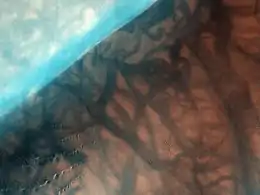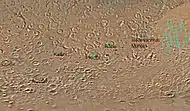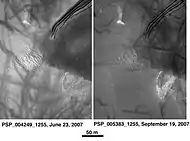Russell (Martian crater)
Russell is a crater on Mars, located in the Noachis quadrangle at 54.9° south latitude and 347.6° west longitude. It measures approximately 135 kilometers in diameter and was named after American astronomer Henry Norris Russell (1877–1957).[1]
 The Russell Crater dune field is covered seasonally by carbon dioxide frost. Numerous dark dust devil tracks can be seen meandering across the dunes. | |
| Planet | Mars |
|---|---|
| Coordinates | 54.9°S 347.6°W |
| Quadrangle | Noachis quadrangle |
| Diameter | 135.08 km |
| Eponym | Henry Norris Russell, American astronomer (1877–1957) |
Description
Debris flows have been observed on some of the dunes in this crater. Some researchers believe that they may be caused by liquid water. Liquid water could be stable for short periods of time in the summer in the southern hemisphere of Mars. These gully-like debris flows may be due to small amounts of ice melting.[2] Another idea is that chunks of dry ice form on the dunes during the cold winter, then slide down in the spring when it is warmer. Experiments have demonstrated that carbon dioxide from the thawing dry ice forms a lubricating layer under pieces of dry ice, making it easy for the process to take place.[3][4]
 Quadrangle map of Noachis labeled with major features. Russell Crater is near the bottom left.
Quadrangle map of Noachis labeled with major features. Russell Crater is near the bottom left. Topographical map showing location of Russell Crater and other nearby craters
Topographical map showing location of Russell Crater and other nearby craters
 Russell Crater dust devil changes, as seen by HiRISE. Click on image to see changes in dust devil tracks in just 3 months.
Russell Crater dust devil changes, as seen by HiRISE. Click on image to see changes in dust devil tracks in just 3 months.
Gullies on dunes
Gullies are found on some dunes. These are somewhat different from gullies in other places, like the walls of craters. Gullies on dunes seem to keep the same width for a long distance and often just end with a pit, instead of an apron. Many of these gullies are found on dunes in Russell (Martian crater).[5]
 Wide view of dunes in Russell Crater, as seen by HiRISE Many narrow gullies are visible.
Wide view of dunes in Russell Crater, as seen by HiRISE Many narrow gullies are visible. Close view of the end of gullies in Russell Crater, as seen by HiRISE Note: These type of gullies do not usually end with an apron. The location is Noachis quadrangle.
Close view of the end of gullies in Russell Crater, as seen by HiRISE Note: These type of gullies do not usually end with an apron. The location is Noachis quadrangle. Close view of the end of gullies in Russell Crater, as seen by HiRISE
Close view of the end of gullies in Russell Crater, as seen by HiRISE Close, color view of the end of gullies in Russell Crater, as seen by HiRISE
Close, color view of the end of gullies in Russell Crater, as seen by HiRISE
See also
References
- "Gazetteer of Planetary Nomenclature | Russell". usgs.gov. International Astronomical Union. Retrieved 4 March 2015.
- Reiss, D, R. Jaumann. 2003. Recent debris flows on Mars: Seasonal observations of the Russell Crater dune field. Geophysical Research Letters: 30, 1321.
- http://www.jpl.nasa.gov/news/news.php?release=2013-200
- http://www.space.com/21539-mars-gullies-dry-ice-sleds.html
- McEwen, A., et al. 2017. Mars The Pristine Beauty of the Red Planet. University of Arizona Press. Tucson.